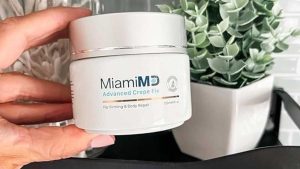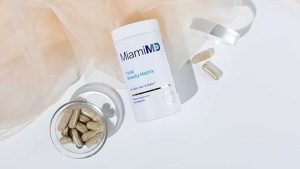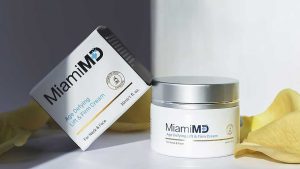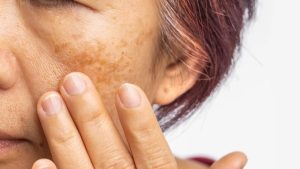Why Skin Gets Shiny And How To Avoid It

Shiny skin is not radiant, glowing skin. If you deal with skin that looks more like an oil slick than the beautiful, youthful-looking skin you’ve been dreaming of, you likely already know how frustrating it can be.
But why does shiny skin happen, and what can you do to keep it in check?
Buckle up… Miami MD has all the answers you need to make sure your skin looks and feels the way you deserve it to look. After all, shouldn’t your outside appearance match how beautiful you are on the inside?
Why Shiny Skin Happens
First and foremost, sebum (oil) is a good thing! While no one wants to walk around looking oily, oil production is a natural part of creating what is known as the body’s moisture barrier.
The moisture barrier helps to keep the skin hydrated, protecting it against moisture loss from both inside and out. When it is damaged, you’re far more likely to notice the signs of dry, dehydrated skin.
That sebum is produced by sebaceous glands, which are on nearly every part of the body — except for the hands and feet. It is also a natural lubricant for body hair, which is why they are mostly found attached to hair follicles.
Sebum is composed of fatty acids known as ceramides, fat molecules that do most of the heavy lifting when creating the moisture barrier.
Unfortunately, the skin isn’t very thick, especially on the face.
Any excess sebum will show up as a coating on top of the skin, which is what makes the face look so shiny. There are more sebaceous glands located in the “T-Zone” on the face as well, which is why your forehead, nose, and chin are likely to appear shiny.
Generally speaking, the skin should have some shine on it to indicate that your moisture barrier is functioning as it should. Skin that is dull or matte in appearance is most likely due to dehydration. It may also be the result of a poor diet or insufficient sleep.
A good rule of thumb is tracking how long it takes, from washing your face to having your skin appear shiny again. If you wash your face in the morning and it appears shiny by lunch, you are likely dealing with excess sebum production.
Common Mistakes People With Shiny Skin Make
You may be contributing to making your skin shinier than it already wants to be without even knowing it. In fact, what many people do thinking that they’re helping their skin can actually create more problems.
Excessive Washing
The number one mistake is to wash your face more often when your skin is at its shiniest. The logic behind doing this is reasonable… if your skin is looking oily and shiny, you’d want to rinse all that off, right?
Shiny skin still needs to be washed regularly, especially if you want to avoid acne and other related skin concerns. However, washing your face too frequently can worsen the problem.
Although it may be tempting, don’t wash your face any more than twice a day. When you wash your face excessively, it triggers sebum production to increase.
While you may get a brief respite from having shiny skin, the oil will start to build up even more quickly than before. This happens because of excessively washing the skin, especially with the wrong products, or more often than recommended. As a result, this can dry the skin out.
The drier the skin, the more the body thinks it needs to produce more sebum to protect it.
Scrubbing Too Hard
Another common mistake is to scrub your skin too hard when you do wash your face. The skin should never be scrubbed, no matter what your skin type may be.
Not only does scrubbing not remove any more dirt and debris than normal face washing, but it may also trigger the sebum production to kick into overdrive. The same goes for using cleansing brushes or scrubs, and less is better when it comes to preventing shiny skin.
Oily Makeup
Your makeup can also be a major contributor to how shiny your skin appears. It’s normal to want to cover up skin with obvious imperfections using makeup, which has become an art form.
However, when you use products on your skin that contain oil themselves, it worsens the problem instead of helping to camouflage it.
Look for makeup products, especially foundation, that are “oil-free” and “noncomedogenic.” Always make sure that you take off your makeup at the end of the day instead of falling asleep with it on your face.
How to Deal With Shiny Skin
Wash your face twice a day, using effective products that were designed for your specific skin type. This often includes a skincare regime with hydroxy acids. You may see these listed as either AHAs (alpha-hydroxy acids like glycolic acid) or BHAs (beta hydroxy acids like salicylic acid) on an ingredient list.
In general, most dermatologists recommend BHAs for people with oily, shiny skin as they are oil-soluble and can get deeper into the pores to help control the amount of sebum trapped inside.
You may also want to include a targeted supplement meant to enhance the health of your skin, like Miami MD’s Total Beauty Matrix.
Supplements like these help target common issues that skin develops as it naturally ages by:
- Supporting collagen production (making your skin appear more firm)
- Reducing the appearance of fine lines and wrinkles
- Fighting back against hormones that may be prematurely aging your skin.
- Support for hair and nail growth
Blotting Paper
Another tip recommended by professional dermatologists, like those at the American Academy of Dermatology Association, is to use blotting papers.
Blotting papers are specially formulated for helping to soak up excess oil on the face without rubbing or washing. Gently press them on any areas that may be extra shiny, leave it on for a few seconds, and remove.
You may also want to include other products in your daily skincare routine that can help cut through the amount of oil that sits on the surface of your skin.
Water-Based Toners
Look for a toner that is made specifically for oily skin, preferably one that is not alcohol-based — it may be too harsh for your skin and trigger additional oil production. You’ll want to apply it after you have cleansed your skin but before you’ve added any serums or moisturizers.
Moisturizers
And finally, speaking of moisturizers, it’s important to always follow up any skincare routine with one. Some people who have oily, shiny skin think that using moisturizers can hurt instead of actually helping.
However, as we now know, dry skin actually leads to excess oil production and worsens the issue. When you use a moisturizer that is formulated for oily skin, it helps your skin naturally reduce the amount of oil it produces.
While you should use it sparingly and even skip the areas that tend to be the oiliest (like the nose), it will help your body not feel like it has to work as hard.
It’s OK to Blame Genetics
Unfortunately, no matter what you do, oily skin just won’t go away if it runs in your family.
While you can change up your skincare products, reduce your stress level, and monitor your hormone levels, one thing that you can’t change is your genetic makeup.
Skin type is often the result of genetics, whether that means you tend to have dry skin, oily skin, or a combination of both.
The size and amount of sebaceous glands may also come down to genetics. Some people are born with naturally larger sebaceous glands or more of them in certain areas. Pore size and even the amount of sebum you produce can also be related. This has even been documented to differ based on your ethnic background.
For instance, those with an Asian background tend to have smaller pores and less sebum production. On the other hand, African Americans have naturally larger pores, which lead to higher sebum production.
If you’re struggling with shiny skin, check with your family members. They may be able to give you some insight into whether or not it’s a genetic issue and what has –or hasn’t — worked for them.
While you can’t change your genetics, you can still get some great advice.
In Conclusion
Shiny skin isn’t optimal, but it is manageable.
Start with the right skincare routine and throwing out any old habits that can worsen your skin. Instead of making your skin appear at its best, focus on helping your skin return to its best possible condition.
Miami MD is here for you, from the inside out, with both the knowledge and the products you need to live your best life. After all, your skin is worth it.
Sources:
Sebum – an overview | ScienceDirect Topics
How to control oily skin | American Academy of Dermatology Association
Ethnic differences in the structural properties of facial skin | National Library of Medicine





